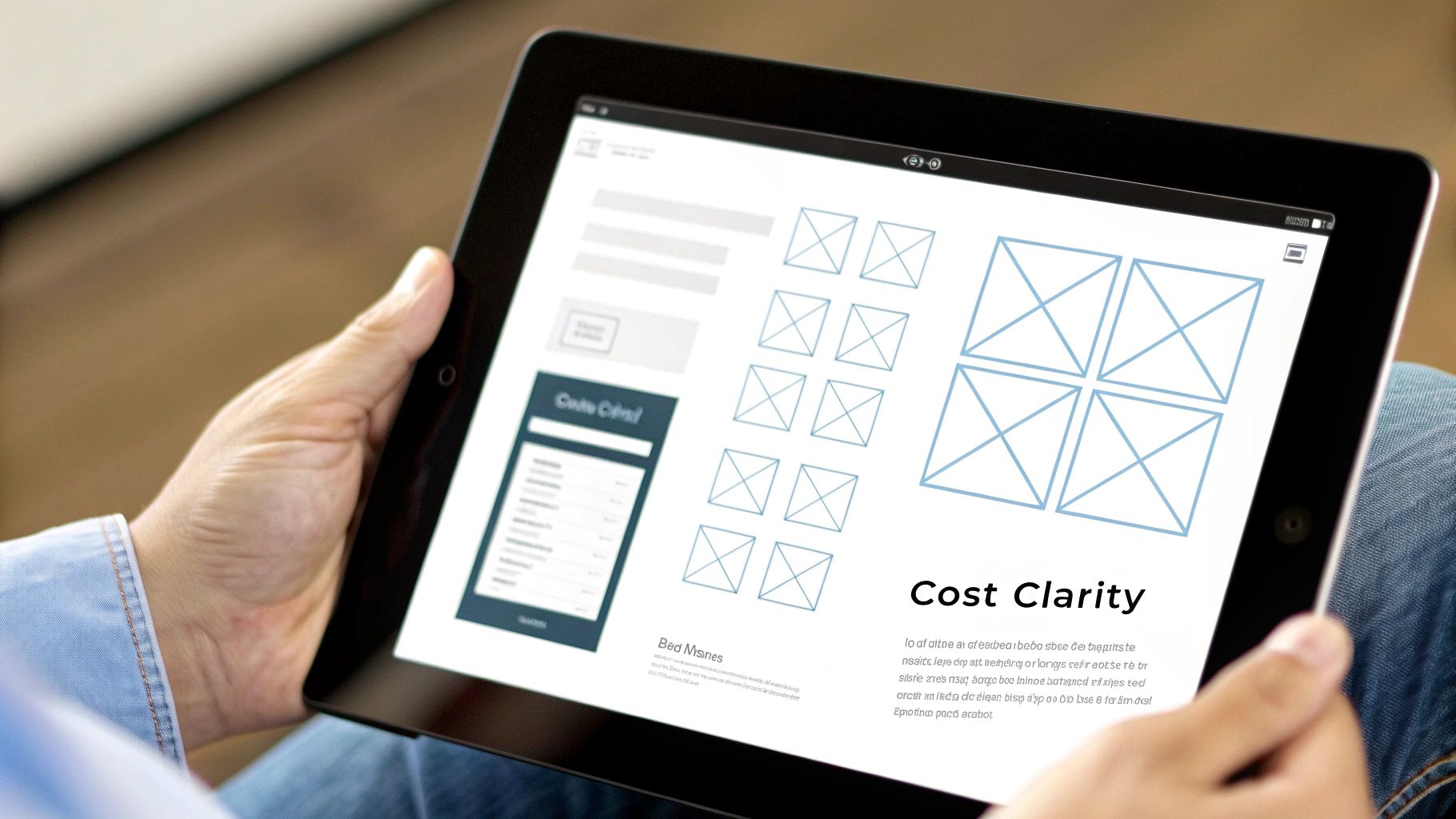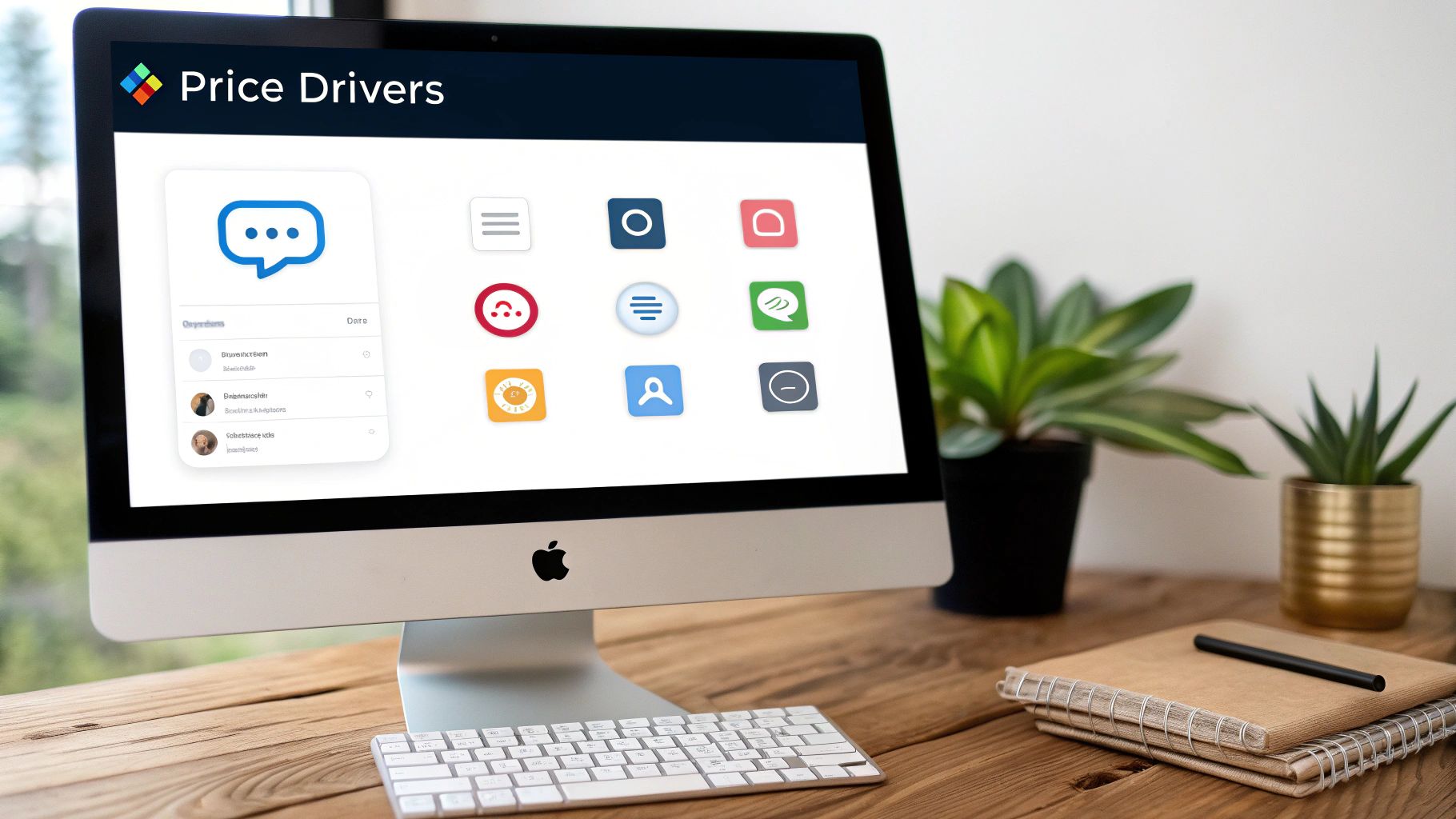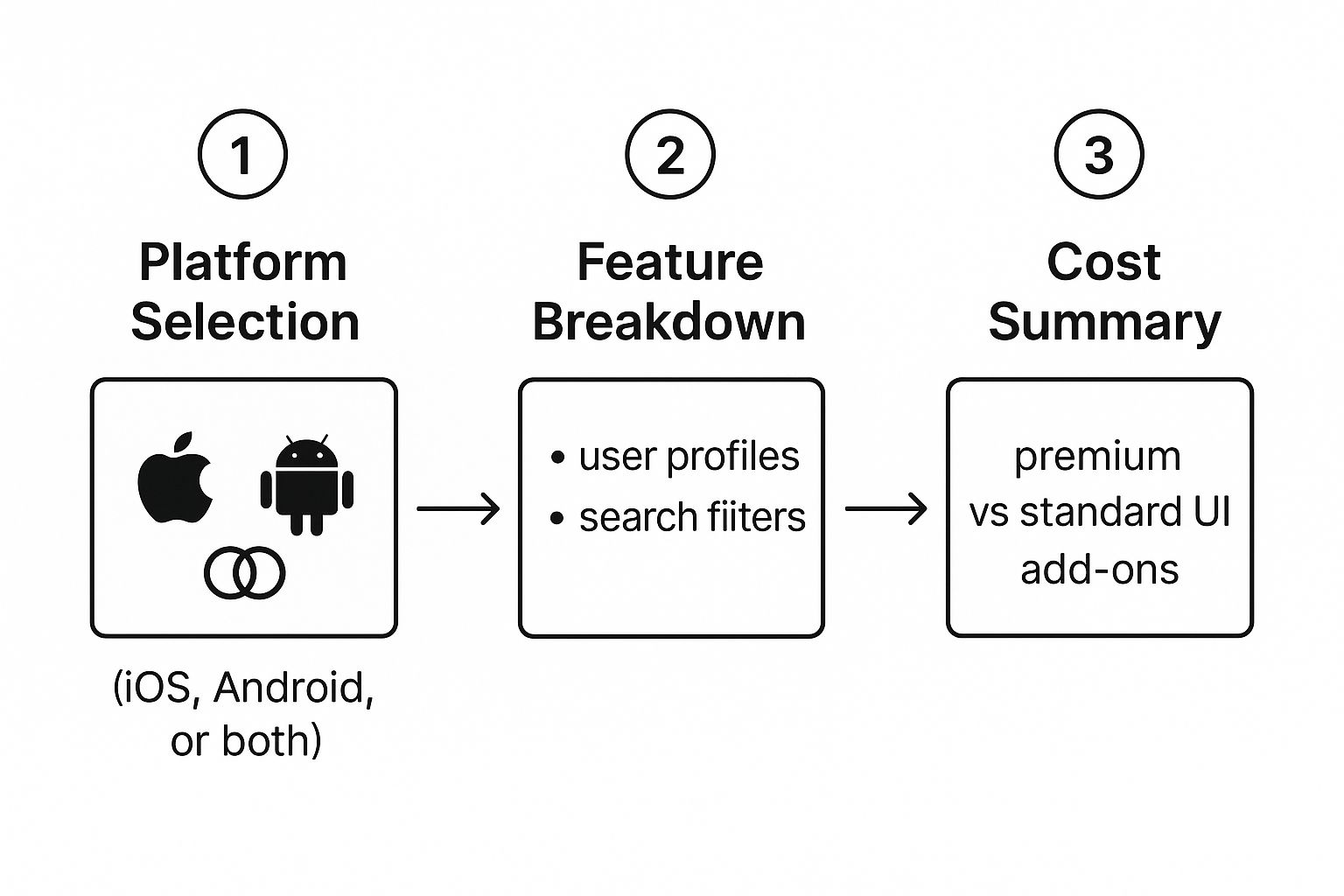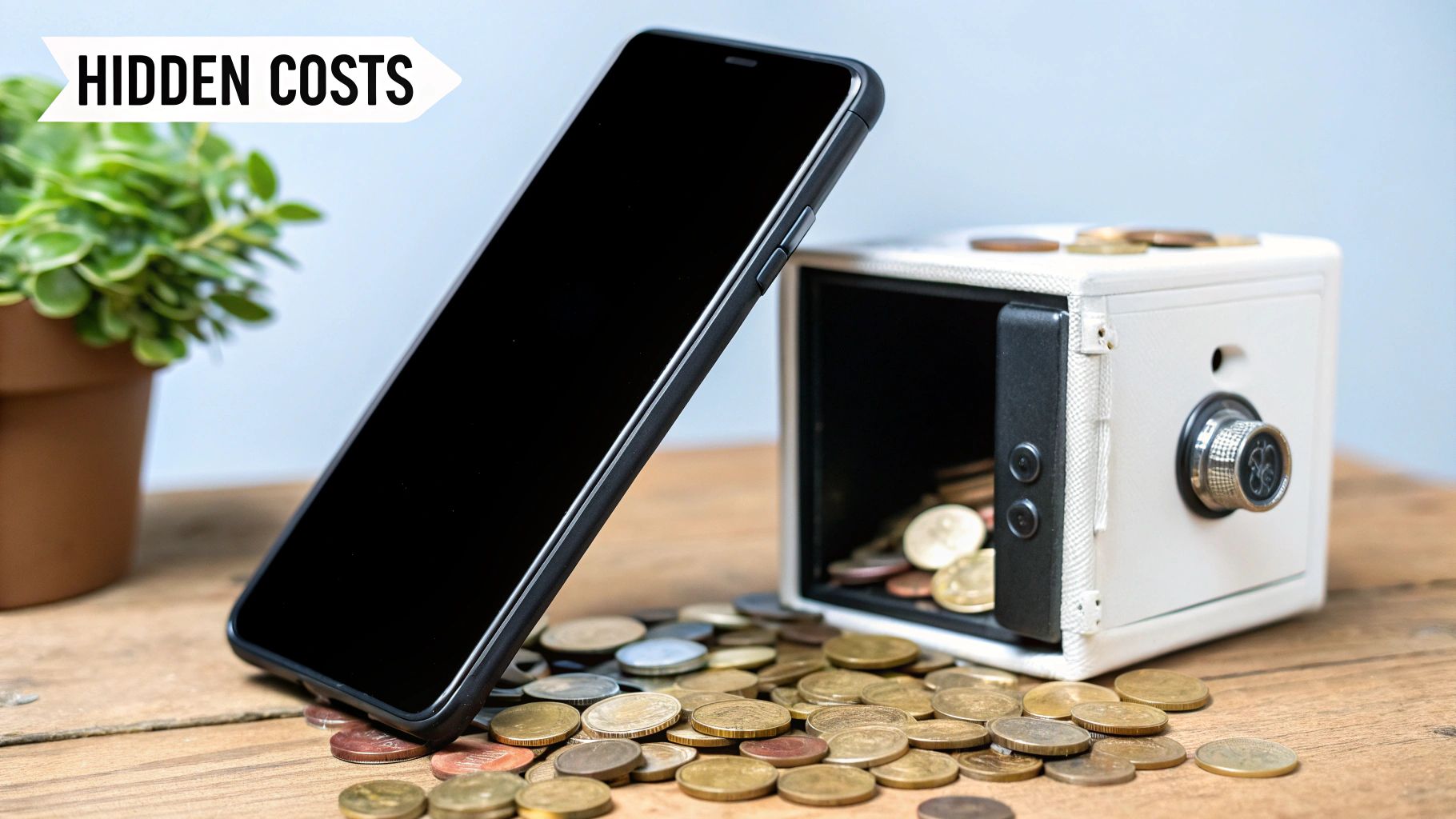Your Guide to the App Development Cost Calculator
October 14, 2025

An app development cost calculator is an online tool designed to give you a quick, ballpark budget estimate for your project. By toggling a few options for features, platforms, and design complexity, you can turn a vague idea into something with a real financial scope.
How an App Cost Calculator Demystifies Your Budget#

Ever feel like the cost of building an app is a complete mystery? You're not alone. The process can feel like a black box, with prices fluctuating wildly based on who you talk to. This is where an app development cost calculator brings some much-needed clarity right from the start.
The tool works by breaking down your grand vision into smaller, more tangible pieces. Instead of just thinking "I need a social media app," the calculator forces you to get specific about the ingredients:
- User Authentication: Will users log in with email, their social media accounts, or both?
- Core Functionality: Does it need real-time chat, a photo feed, or location-based services?
- Platform Support: Are you targeting just iPhone users, just Android users, or everyone?
Each one of these choices translates directly into development hours and, in turn, your budget. Think of the calculator as a guided brainstorming session that just happens to attach a price tag to every decision.
From a Guess to a Guided Plan#
Using a calculator takes your project from a hopeful guess to a structured, budget-aware plan. For example, a simple content-delivery app for a local blog might only need minimal backend work and a straightforward UI. The calculator would reflect this with a lower cost estimate.
On the other hand, a full-blown e-commerce platform with secure payment gateways, a complex inventory database, and personalized user recommendations is a much bigger beast. The calculator will show a significantly higher figure, immediately setting realistic expectations. This process isn't just about getting a number; it’s about starting a strategic conversation about what’s truly essential for your app’s first version—what we call a Minimum Viable Product (MVP).
Here are the primary factors an app cost calculator weighs and how they influence the final estimate.
Key Inputs and Their Impact on Your App's Cost#
| Calculator Input | What It Really Means | Impact on Your Budget |
|---|---|---|
| Platform | Will your app be on iOS, Android, or both? | Building for two platforms doubles much of the work, significantly raising the cost. Cross-platform tools can lower this, but it's still a major factor. |
| Design Complexity | Is the UI simple and standard, or does it require custom animations and branding? | A basic, template-based design is cheap. A unique, highly polished UX with custom graphics and animations requires far more designer and developer hours. |
| User Features | Does the app need user profiles, social logins, and activity feeds? | Every user-centric feature adds complexity to the database, backend logic, and UI, pushing the cost up. |
| Admin Panel | Do you need a backend dashboard to manage users, content, and settings? | A powerful admin panel is like a second app. It requires its own design, development, and testing, adding a substantial amount to the budget. |
| Integrations | Will the app connect to third-party services like payment gateways or mapping APIs? | Integrating external services adds development time for research, implementation, and testing, which directly increases costs. |
As you can see, each selection is a trade-off. The calculator helps you visualize those trade-offs in real time, making it easier to prioritize what really matters for your launch.
Key Takeaway: An app cost calculator is more than a budgeting tool—it's a strategic planning resource. It helps you prioritize features, understand cost drivers, and build a realistic roadmap for your MVP launch.
The price range for mobile apps is vast. A simple app might cost between $40,000 and $100,000, taking 3 to 6 months to build. However, a more advanced app with complex integrations can easily run between $200,000 and $400,000, with a development timeline of 9 to 12 months.
By understanding this spectrum, you can use the calculator to find where your project fits. For an even deeper look into your budgeting process, check out our complete guide on how much app development costs.
The Core Factors Driving Your App's Price Tag#

Alright, let's pull back the curtain on what really moves the needle on your app development budget. Any app development cost calculator worth its salt is built around a few core drivers. Getting a handle on these is the first step, long before you start plugging in numbers.
These are the big-ticket items that can make your estimate swing from a modest project to a major investment. Think of building an app less like a single task and more like a series of strategic decisions. Every choice has a direct impact on the final cost.
App Complexity: The Biggest Cost Driver#
The single most influential factor is, without a doubt, your app's complexity. And I'm not just talking about the sheer number of features; it's about what those features actually do.
A simple, static app—like a digital brochure for a local business—sits on the low end of the cost spectrum. It’s mostly just displaying information and needs very little in terms of backend logic or database work.
But the moment you start adding dynamic functionality, the hours and the costs start to climb. Fast.
- Real-time chat? That requires a complex backend to manage instant message delivery.
- AI-powered recommendations? Now you're talking machine learning models, data processing, and sophisticated algorithms.
- Payment processing? That means secure integrations with gateways like Stripe or PayPal, plus a ton of testing to make sure it's bulletproof.
Each of these adds layers of work, from backend APIs to the user-facing interfaces, and will dramatically inflate the budget.
The Platform Debate: iOS, Android, or Both?#
Your choice of platform is another monumental decision. Are you targeting iPhone users, the Android crowd, or everyone? This question leads to a fundamental fork in the development road.
Key Insight: Choosing between native and cross-platform development is a classic trade-off between performance and budget. Native apps offer the best user experience but require separate codebases, while cross-platform solutions can cut initial costs by up to 40%.
Here’s how it breaks down:
- Native Development: This means building separate, dedicated apps for iOS (using Swift) and Android (using Kotlin). It delivers peak performance and a seamless user experience, but you're essentially paying to build two different applications from the ground up.
- Cross-Platform Development: Using frameworks like React Native or Flutter lets your team write one codebase that works on both platforms. It's often faster and more budget-friendly upfront, but it can come with performance trade-offs for really demanding, high-performance apps.
UI/UX Design: The Visual Price Tag#
Finally, don't ever underestimate the cost of design. A clean, simple, and intuitive user interface (UI) that uses standard, off-the-shelf components is far more budget-friendly. It lets developers build quickly without having to reinvent the wheel.
On the other hand, a highly customized, animation-heavy user experience (UX) demands a huge amount of time from both designers and developers. Custom icons, slick page transitions, and unique visual elements all add to the timeline and the bill. Great design is almost always worth the investment, but you have to recognize it as a distinct and significant cost factor.
Of course, beyond the features and platform, how efficiently your team works plays a huge role. Simple strategies to improve developer productivity can have a direct impact on your timeline and final spend. If you want to get into the technical weeds, check out our guide on choosing the right mobile app tech stack.
A Practical Walkthrough of an App Cost Calculator#
Alright, let's move from theory to actually using one of these things. An app development cost calculator is way more useful when you see it in action, so let's walk through a real-world scenario together. We'll pretend we're building a fictional food discovery app called 'LocalEats.'
The idea behind LocalEats is simple: help people find unique, locally-owned restaurants. This isn't just about clicking a few buttons on a calculator; it’s about making strategic choices that reflect the project's real budget and priorities.
Setting the Foundation: Platform and Design#
The first questions any good calculator will ask are about your foundation. For LocalEats, we want to hit the biggest audience right out of the gate, so we’ll select development for both iOS and Android. This decision immediately bumps up the cost compared to a single-platform app, since it means building for two totally separate operating systems.
Next up is the UI/UX design. The options are usually something like 'Standard,' 'Polished,' or 'Premium.'
- Standard UI: Uses the basic, out-of-the-box components. It works, but it won't win any design awards.
- Premium UI: We're talking custom animations, slick branded elements, and a user experience that feels completely unique.
For our first launch, we’ll go with 'Polished.' It’s the smart middle-ground—it gives you a great user experience without the hefty price tag of a fully custom design. This one choice can easily save $10,000-$20,000 compared to a premium build.
This infographic gives you a good sense of the decision flow you'll go through.

As you can see, your choices cascade. Each decision builds on the last, shaping that final cost estimate.
Selecting Core and Advanced Features#
Now for the most detailed part: the features. Calculators usually present these as a big list of checkboxes or dropdowns. For LocalEats, we’ll pick a core set of features to launch with—our Minimum Viable Product (MVP).
Essential Features for the LocalEats MVP:
- User Profiles: People need to sign up, log in, and save their favorite spots.
- Search & Filters: The ability to search by cuisine, location, and price is completely non-negotiable.
- Review System: Users have to be able to leave ratings and write reviews.
Each of these adds a real chunk of development time. A simple login feature might take 20-40 hours, but a more complex review system with photo uploads could easily top 100 hours. The calculator is designed to translate those hours into dollars.
We're also going to add Push Notifications to let people know about new restaurants nearby. This is a key feature for user engagement, but it can add $3,000-$8,000 to the budget because it requires setting up a backend and integrating with Apple's and Google's notification services.
Pro Tip: Your first estimate will almost always be higher than you expect. Don't panic. Use it as a prioritization tool. If the cost is too high, uncheck a "nice-to-have" feature like social sharing or a fancy loyalty program and watch how it impacts the total. The goal is to define your MVP and keep those initial costs lean.
Understanding how these selections drive the final number is everything. The cost isn't just about the features themselves, but also how they interact with each other, which adds to the overall complexity and timeline. If you want to get a better handle on project duration, you can learn more about the typical mobile app development timeline in our other guide.
Alright, you've plugged in the numbers and the app development cost calculator has given you a figure. That's a huge step. But hold on—that number isn't the final price tag. It's your starting point.
Think of that estimate as a realistic range, not a single, fixed cost. The lower end of that range probably points to a simpler design built by a team with more modest hourly rates. The higher end? That likely covers a more polished user experience, a few advanced features, and the expertise that comes with a premium development agency. Your first job is to figure out where your project realistically fits on that spectrum.
Turn Your Idea into a Clear Project Brief#
With a budget range in hand, it's time to get your idea down on paper. I’m not talking about a massive, hundred-page technical spec. You need a short, sharp project brief that a development agency can actually read and understand in a few minutes.
This brief is the bridge between your calculator result and a real conversation with a potential partner. A good one immediately shows you’ve done your homework.
Here’s what you absolutely have to include:
- The Core Problem: In one or two sentences, what pain point does your app solve? For instance, "An app that connects local home gardeners so they can share or trade their surplus produce."
- Your Target User: Who is this for? Get specific. "Busy urban professionals, 25-40 years old, who want fresh, organic food but don't have the space to grow it themselves."
- Must-Have Features (MVP): List the non-negotiable features you identified with the calculator. This is your Minimum Viable Product—just what's needed to launch.
- Your Budget Estimate: Don't be shy. Share the range you got from the calculator. It sets realistic expectations right from the first call.
Have Smarter Conversations with Developers#
Armed with your brief and your budget estimate, you’re ready to start talking to development agencies. This prep work completely changes the conversation. You’re no longer walking in and asking a vague question like, "So, how much does an app cost?"
Instead, you can lead with confidence and clarity.
Key Takeaway: An estimate from an app development cost calculator isn't just a number. It's the key to crafting a focused project brief that empowers you to have productive, budget-aware discussions with potential development partners.
Now, you can open the conversation like this: "We're looking to build an MVP with these three core features for this specific audience. Our initial research puts the project in the $60,000 to $90,000 range. Does that align with what you typically see for this kind of scope?"
That one question instantly positions you as a serious, well-prepared founder. It saves everyone time, helps you quickly filter out agencies that aren’t the right fit, and starts your potential partnership on a foundation of transparency.
Suddenly, that calculator result has become your most powerful tool for finding the right team to bring your vision to life.
Uncovering the Hidden Costs of App Ownership#

That number you get from an app cost calculator? It’s a great starting point, but it's really just the tip of the iceberg. It covers the initial build—the design, coding, and testing needed to get your app live on the App Store or Google Play. What catches most first-time founders off guard are all the expenses that kick in after the launch.
Too many people see building an app as a one-and-done project. It’s not. It’s the beginning of a business, and that business has running costs. We call this the total cost of ownership, and understanding it is the difference between a successful app and a failed one.
The Inevitable Cost of Maintenance#
Your app will never, ever be "finished." Every year, Apple and Google release new versions of iOS and Android. These updates can break things in your app, creating compatibility issues that need to be fixed just to keep it working.
Bugs will always pop up, and some will need immediate attention. On top of that, new security vulnerabilities are discovered all the time, and you have a responsibility to patch them to protect your users' data.
This ongoing app maintenance is a real and recurring expense. A solid rule of thumb is to budget 15% to 20% of your initial development cost, every single year, just for maintenance. So, if your app cost $100,000 to build, you should plan on spending $15,000 to $20,000 each year simply to keep the lights on.
"The total cost of an app development project often follows a simple formula: development hours multiplied by the developer's hourly rate. However, the financial story doesn't end there. Savvy businesses also account for ongoing app maintenance, which can range from 15% to 25% of the original development cost per year, ensuring the app remains functional and competitive." - Topflight Apps
Beyond the Codebase Costs#
Maintenance is just one piece of the post-launch puzzle. Your app needs a home and tools to do its job, and those all have their own price tags.
Server and Hosting Fees: All your app's data—user profiles, content, backend logic—has to live on a server. For a small app, this might be a modest monthly fee. But for an app with heavy traffic, server costs can easily run into the thousands per month. Choosing the right architecture from the start is critical. Exploring a serverless backend for mobile apps can give you a good idea of how to manage these costs effectively.
Third-Party Service Subscriptions: Does your app use maps, process payments, or send notifications? Those features are almost always powered by third-party services like Google Maps, Stripe, or Twilio. These powerful APIs are rarely free. They typically operate on a subscription or pay-as-you-go model that scales with your user base.
Marketing and User Acquisition: You could build the best app in the world, but if nobody knows it exists, it's just a file on a server. You absolutely must have a budget for marketing. This could be anything from social media ads and content marketing to influencer outreach, but it's the only way you'll attract and, more importantly, keep an audience.
Questions Everyone Asks About App Cost Calculators#
Even with the best tools, jumping into app budgeting can feel like stepping into the unknown. An app development cost calculator is a brilliant starting point, but it's totally normal to have questions about what the numbers really mean. Let's tackle some of the most common ones I hear.
How Accurate Are These Online Calculators, Really?#
Think of an online calculator as a well-informed ballpark estimate, not a final, legally-binding quote. Its accuracy is a direct reflection of how much detail you put in. If you just blast through the options with generic clicks, you're going to get a very broad, almost vague, price range.
But if you take a moment to thoughtfully consider each feature, platform, and design choice, the result transforms into a much more reliable tool for your initial budget planning. It’s perfect for seeing exactly how adding "just one more feature" can impact your overall costs.
For a precise, fixed quote, you'll always need to sit down and talk with a development agency. They’re the ones who can dive deep into your specific business logic, technical needs, and long-term goals to craft a concrete proposal.
Key Insight: A calculator's estimate is your starting point for refinement, not a final verdict. If the initial number is higher than your budget, it's a clear signal to go back and simplify your Minimum Viable Product (MVP).
Can I Lower My App Cost After Getting an Estimate?#
Absolutely. In fact, this is one of the biggest benefits of using a calculator early on. If that first estimate makes your jaw drop, don’t panic—it’s just a data point. Now it’s time to strategize.
Go back to the calculator and start tweaking the variables. What happens if you launch on a single platform first instead of both iOS and Android? Can you simplify the UI/UX design from "Premium" to "Polished" for the first version? Each of these changes can slash the cost significantly.
The key is to strip your app down to its most critical, core features for launch. Every "nice-to-have" feature you postpone is money saved upfront that you can reinvest later on, guided by real user feedback instead of guesswork.
I Have My Estimate... Now What?#
Once you have your estimate, your next move is to put together a simple project brief. This doesn't need to be a novel, but it should clearly outline your app's main purpose, who it's for, and the core features you've settled on for your MVP.
With this brief and your budget estimate in hand, you're in a perfect position to start conversations with development agencies or freelancers. The estimate gives you a realistic foundation, helping you find a partner who aligns with both your financial and project goals.
This is also a great time to think beyond just the development costs. It's smart to run the numbers through an app revenue calculator to project potential earnings. This gives you a much fuller financial picture, showing you not just the cost, but the potential return.
Ready to stop guessing and start building? NextNative provides production-ready boilerplates that save you weeks of setup time, letting you focus on your app's unique features. Build and launch your native iOS and Android app faster than ever at https://nextnative.dev.
Explore more
- How to Convert Your Next.js App to iOS & Android
- How to Add Push Notifications to Your Next.js Mobile App
- How to Add In-App Purchases to Your Next.js App
- How to Build an iOS App with Next.js in 2025
- How to Deploy Your Next.js App to the App Store
- Next.js vs React Native
- Capacitor vs React Native
- Capacitor vs Flutter
- Capacitor vs Ionic
- Next.js vs Expo
- PWA vs Native App